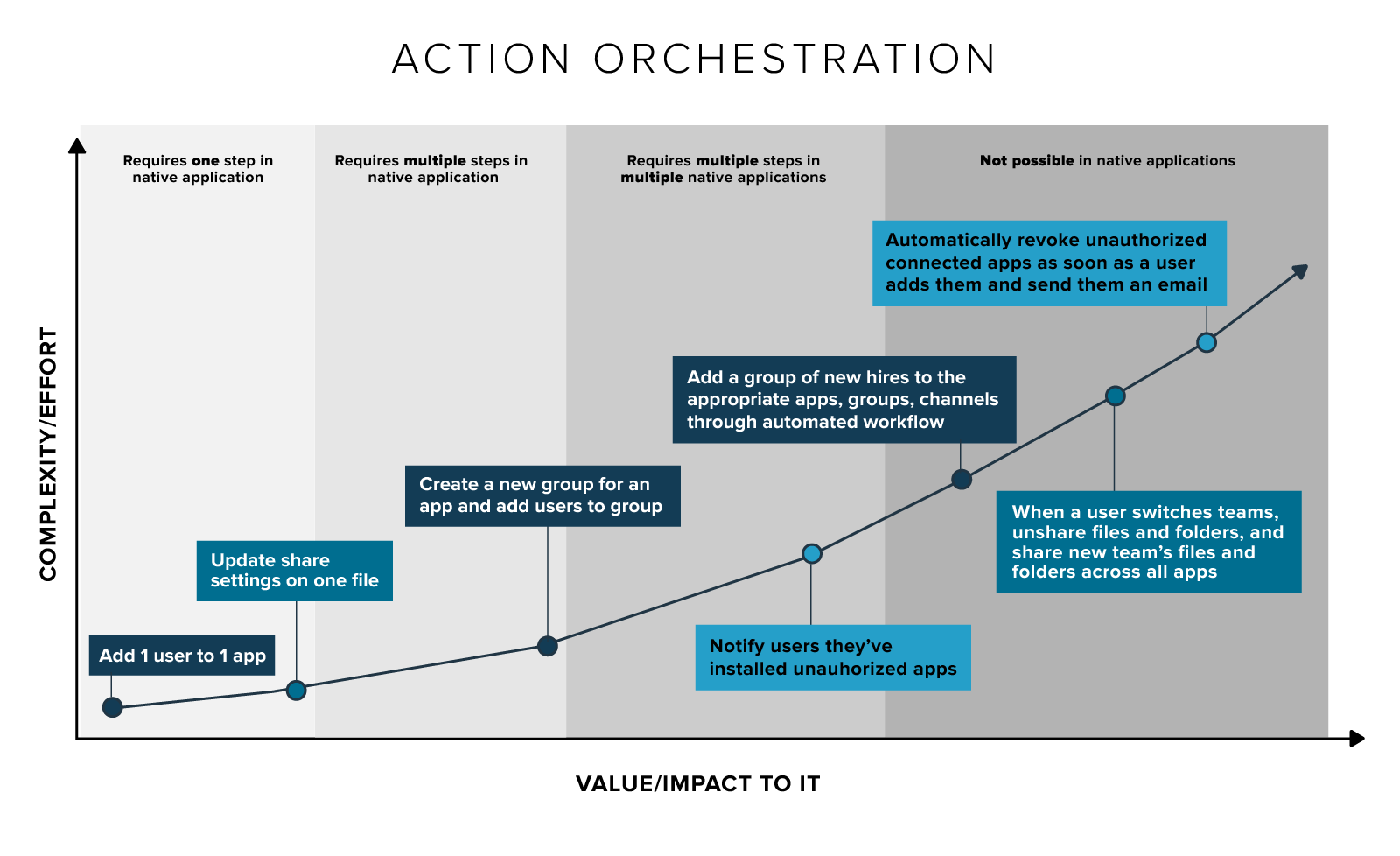SaaS Action Orchestration: The Pinnacle of SaaS Management
April 11, 2017
5 minute read

Think back to when you deployed your first SaaS application.
You might have connected legacy or on-premises IT administration tools (like Active Directory) to it, or written a few custom scripts, but as you introduce additional SaaS apps, this approach doesn’t scale. Over time, more people join, and tasks get more complex. So how do you manage it all?
Automation is the easy answer, but the right long-term solution goes much deeper than simply automating tasks. You need to orchestrate actions.
Actions + Orchestration
First, let’s talk about orchestration.
“Automation was the first step for IT–orchestration is the next step as IT continues to evolve and build upon its successes,” writes TechTarget. “Orchestration services connect task-based concepts and flows within IT to the greater business, using automation to deliver IT services.”
Hmm… seems vague, right? What is the actual work getting done? Good question.
Here’s a thought: The work that truly needs orchestration is actions. You may have the most brilliant SaaS implementation strategy in the world, but when the rubber meets the road post-deployment, these applications don’t manage themselves.
Actions are the routine administrative or operational functions you carry out in native SaaS apps, every single day, over and over and over again. Think: managing user/group membership changes, updating file sharing settings, resetting passwords, responding to alerts, blocking/wiping mobile devices, and so forth.
Putting It Together
So if we put everything together, what does action orchestration mean?
It’s not just about reducing friction for IT or improving processes strategically.
Action orchestration gets in the weeds of SaaS administration and operations, right in the thick of it. Highly tactical and detailed, it takes granular actions and choreographs them into automated workflows. It provides IT deep control by enabling them to automate actions from multiple areas across SaaS lifecycle management, like memberships, settings, files, connected apps, and so forth.
Why Action Orchestration is a Must
Without the ability to orchestrate actions across SaaS applications, IT is faced with two options:
- 1. Scale IT staff alongside SaaS application usage and adoption, or
- 2. Block additional SaaS usage and adoption.
For most organizations, neither option is acceptable, leaving IT between a rock and a hard place, heading upstream without a paddle…. well, you get the idea.
Ultimately, the inability to orchestrate action prevents IT from moving up the value chain.
Take a look at this graph:

Actions are on the left side are simple. Straightforward. They can be done quickly and easily inside an application’s native admin console. Automating these actions is valuable, if only moderately.
But over time, these actions become more complicated. More people join your organization. More SaaS applications are adopted. And suddenly, you have to log into dozens of different admin consoles just to update something for one user. Eventually, these actions get so complex that it becomes impossible to even do them–much less automate them–in their native admin consoles. At some inevitable point, scaling is not feasible.
The more complex these operational actions get, the more value you get out of orchestration. This value rises exponentially.
The Power of Action Orchestration
True SaaS action orchestration strings together disparate data objects, events, and automations–whether it’s just within one SaaS app or across multiple. It coordinates API calls to multiple SaaS applications and connects them together. It manages the flow of actions. It takes into account centralized data and operational intelligence in order to streamline automated workflows. It’s the pinnacle of SaaS management.
Action orchestration amplifies the benefits of automation, enabling IT to save time but also:
- Reduce (or remove) human error and improve consistency. To err is human. But I need only point to Amazon’s recent “Oops, we broke the internet with a typo” fiasco to stress that human error can sometimes have disastrous consequences. (According to one estimate, Amazon’s outage cost S&P 500 companies $150 million, and US financial service companies $160 million in lost revenue.) Additionally, routine tasks can lead to mistakes. Researchers gave volunteers a repetitive task to do in the presence of distracting information and found that they made a mistake about 10% of the time. And according to Infosecurity Magazine, human error is the number one cause of data breaches. Automating one action reduces the chance of human error, but orchestrating multiple actions reduces it even more.
- Help ensure compliance. IT must ensure that their organizations remain compliant with company policies, as well as industry standards like SOX, PCI, HIPAA, and FERPA. Orchestration can help ensure nothing falls through the cracks and that sensitive information remains confidential. For example, while automation can alert you that a file is shared publicly, orchestration can alert you based on specific triggers, send the file owner a notification email, and change the file’s sharing setting to Private–all in one workflow.
- Improve talent retention. “Are you looking to hire the one-year, Tier 1 helpdesk burnout that creates and offboards accounts?” says Dave Jackson, Director of Infrastructure at WeWork. “Or will you use the headcount for a more skilled support engineer to manage that 30,000-foot view of automation (e.g., account workflows, MDM, etc.)?”
- Enable innovation. IT administrators often must slog through endlessly repetitive, manual work. In fact, some companies have onboarding or offboarding processes that contain 70+ steps (!). This leaves no time to innovate or work on higher-value, long-term projects. If you orchestrate these actions, you could focus on new business solutions or serve as strategic advisors. You can’t do that if you’re mired in tedium every day.
But SaaS Admin Orchestration Isn’t Natively Possible–Here’s Why
However, IT can’t orchestrate actions across multiple SaaS applications effectively today. Consider the following shortcomings:
- No central repository or configuration management database (CMDB) of all IT-sanctioned SaaS apps. There are many SaaS app discovery products in the market (like CASBs, for example) that show all shadow and IT-sanctioned apps being used by an organization. This is mainly for visualizing user activity and enforcing deny/allow security policies around usage and data. But there is no platform that displays sanctioned SaaS apps as a collection of IT assets like management configuration items (CIs), as well as the descriptive and contextual relationships between such IT assets.
- No searchable service catalog of all available SaaS admin actions. How do you know all the various actions you can take on a data object, user, group, or connected app in a SaaS application? You’d have to hunt through each admin console individually. There is no central hub. If you can’t see all of your data in one central place, then you can’t begin to think about orchestrating anything.
- No way to orchestrate actions across SaaS applications. Since each app is its own island–siloed, independent of each other–cross-app automation is full of friction. There’s no easy way to automate administrative actions across apps. You have to log into dozens of admin consoles separately to take actions, which becomes cumbersome and complex. As organizations scale and adopt more SaaS applications, this becomes unsustainable.
- Some actions do not exist natively in a SaaS admin console. Most SaaS application admin consoles are built to take actions as one-offs (i.e., not tied to an ITIL process) as well as cover a subset of all available admin actions. As such, some actions are only available via APIs. Unless you’ve dabbled in scripting, how would you know these actions even exist? For example, you cannot natively change group permissions in G Suite in bulk. You must edit them individually, one by one. Only through the API can you edit them en masse.
Action Orchestration for SaaS is More Real Than You Might Think
Imagine having orchestration at your fingertips–action orchestration that’s purpose-built for IT, purely around managing your SaaS applications. Imagine the ability to orchestrate complex processes that would otherwise be impossible to do in native applications.
That is what we’ve built.
BetterCloud centralizes the controls and functions available in disparate admin consoles into a single hub. Our action orchestration capabilities allow IT administrators to take 100+ actions on users, groups, and files and create powerful, streamlined workflows. Using simple sentence logic, you can easily build their own custom workflows across multiple SaaS applications and conduct one-off, bulk, or automated updates to users, files, or privileges.
Orchestration alone is powerful, but you need to orchestrate actions to truly manage your multi-SaaS environment effectively.
We’ve spent the last two years building the first-ever true multi-SaaS management platform, which centralizes and automates the administration of SaaS applications, launching it in December of 2016. Expect more exciting announcements and functionality like this one throughout 2017 as we add on to the platform. To learn more, request a personalized consultation with our team.






